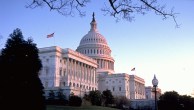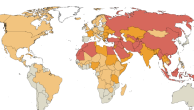The Lynch Decision
A Christmas nativity scene in downtown Pawtucket, R.I., brought the issue of holiday displays to the Supreme Court for the first time. The case, Lynch v. Donnelly (1984), involved the city’s sponsorship of an annual display of holiday decorations, which included a crèche (a manger scene portraying the birth of Jesus) as well as a Santa Claus, reindeer and other figures. The group of residents that brought suit argued that the Christmas display, and especially the crèche, constituted government sponsorship of religion and thus violated the Establishment Clause.
In a 5-4 decision, the Supreme Court ruled that Pawtucket’s display did not violate the Constitution. Writing for the majority, Chief Justice Warren Burger emphasized that government has long had the authority to acknowledge the role that religion has played in U.S. history. This authority suggests, he said, that the Establishment Clause does not require a total exclusion of religious images and messages from government-sponsored displays. He concluded that the local government had included the crèche to “depict the historical origins of this traditional event” rather than to express official support for any religious message.
Lynch v. Donnelly (1984)
| Majority: | Minority: |
| Burger | Blackmun |
| O’Connor | Brennan |
| Powell | Marshall |
| Rehnquist | Stevens |
| White |
Although Burger wrote for the court’s majority, it was Justice Sandra Day O’Connor’s concurring opinion that ultimately proved more influential, establishing the test that courts have relied upon in later cases. O’Connor declared that the Establishment Clause prohibited government from allowing religious belief or membership to impact a person’s position in “the political community.” Government endorsement of religion, she argued, elevates some persons to special status because their beliefs have been officially recognized and denigrates others who do not hold the sanctioned beliefs.
For O’Connor, government endorsement was the key factor. Courts, she argued, should ask whether a “reasonable person” would view the government’s actions as an endorsement of particular religions. But while endorsement is prohibited, she argued, mere acknowledgement of religion, or of religion’s role in the nation’s history, is not.
O’Connor noted that in Pawtucket, the crèche was featured with a Santa Claus figurine and other secular holiday images. In such a context, she concluded, a reasonable person would not see the crèche as a government endorsement of Christianity but rather as one of a number of symbols that were relevant to a holiday that has secular as well as religious significance.
The strongest dissent came from Justice William J. Brennan, who argued that the city of Pawtucket had failed to demonstrate a “clearly secular purpose” for including the crèche. The other, nonreligious objects were more than sufficient, he reasoned, to reach the city’s legitimate goals of encouraging goodwill and commerce. The crèche was added, he concluded, because city officials desired to “keep Christ in Christmas,” and therefore the court could not say that “a wholly secular goal predominates” in the city’s holiday display.
The Allegheny County Decision
Five years after Lynch, the Supreme Court returned to the question of seasonal religious displays sponsored by the government. The new case, County of Allegheny v. ACLU (1989), involved two different displays in downtown Pittsburgh, Pa. One featured a crèche that was donated by a Roman Catholic group and was placed on the main staircase of the county courthouse. The other was a broader display outside a city-county office building that included a menorah owned by a Jewish group, a Christmas tree and a sign proclaiming the city’s “salute to liberty”; it did not include a crèche.
For the court, the case proved unusually divisive. In a notably splintered decision that included nine separate written opinions, the court found the display of the crèche inside the courthouse to be unconstitutional but approved the outdoor exhibit.
One group of justices (William Rehnquist, Antonin Scalia, Byron White and Anthony Kennedy) found both Allegheny County displays permissible. Echoing Burger’s opinion in Lynch, the four justices argued that the Establishment Clause needs to be viewed through the lens of history, which has allowed for substantial government acknowledgment of religion. They argued that although government may not coerce someone to support religion, it should have significant latitude to passively acknowledge religious holidays. In Allegheny County, the four justices concluded, all of the displays, including the crèche, involved only that kind of passive recognition and therefore did not violate the Establishment Clause.
A second group of justices (John Paul Stevens, Brennan and Thurgood Marshall) concluded that both displays violated the Establishment Clause. They argued that the standard that should apply was O’Connor’s test in Lynch – namely, whether a reasonable person would view the government’s action as an endorsement of religion. In their view, both Allegheny County displays failed that test. Whether the displays include symbols representing one, some or all religions, the three justices reasoned, the Establishment Clause bars such endorsement. Religious symbols, they concluded, should be excluded from public displays unless the symbols are fully integrated into a clearly secular message.
County of Allegheny v. ACLU (1989)
In Allegheny County, the court addressed the constitutionality of two displays as separate questions, producing two different majorities of justices. Only Justices O’Connor and Blackmun were in both majorities
| Both Displays Permissible: | Both Displays Unconstitutional: |
| Kennedy | Brennan |
| Rehnquist | Marshall |
| Scalia | Stevens |
| White |
Uphold outside display, strike down inside display: Blackmun O’Connor
O’Connor, along with Justice Harry Blackmun, represented the swing votes in the case. Applying the endorsement test she had introduced in Lynch, O’Connor cited both the particulars of the crèche as well as its setting to conclude that it represented an unconstitutional endorsement of Christianity. She pointed out that the courthouse crèche included the figure of an angel bearing a banner with the Latin phrase meaning, “Glory to God in the Highest,” and that the crèche was displayed by itself in the “most beautiful” part of the county building. Thus, she concluded, a reasonable observer would perceive the display as an endorsement by the city of the religious message that the birth of Jesus was an event of great religious significance.
In contrast, O’Connor said, the outside display, which included the menorah, Christmas tree and “salute to liberty” sign, did not represent an endorsement of religion. Although she acknowledged the religious character of the menorah and the partial religious character of the Christmas tree, she determined that a reasonable observer would see in those multiple symbols a message of religious tolerance and diversity. The display, in its particular setting, “conveys neither an endorsement of Judaism or Christianity nor disapproval of alternative beliefs,” she concluded.
Religious Holiday Displays and the Lower Courts
While Allegheny County is the Supreme Court’s most recent word on seasonal religious displays, the lower federal courts have remained very engaged in the issue. The courts’ application of O’Connor’s endorsement test has led to different outcomes. In deciding whether a reasonable observer would view a particular display as an endorsement of religion or of a holiday’s religious meaning, courts have had to consider the smallest details of each display. The significant factors have included the precise location of the display; the extent to which it includes secular symbols, such as a Christmas tree; the exact placement of the more religious symbols, such as a crèche or a menorah; and the extent to which the display reflects the religious diversity of the community. In these lower federal court cases, different judges have frequently reached very different conclusions based on very similar facts.
For example, in ACLU v. City of Chicago (1987), a divided panel of the 7th U.S. Circuit Court of Appeals found unconstitutional a Christmas display in Chicago’s City Hall. The display included a nativity scene as its centerpiece, surrounded by a Christmas tree, a Santa Claus figure and other secular symbols of the holiday. The court, emphasizing the display’s location within the seat of government, determined that a reasonable observer would conclude the city was endorsing the holiday’s religious significance. In his dissent, the court’s chief judge, Frank Easterbrook, complained that the endorsement test required “scrutiny more commonly associated with interior decorators than with the judiciary.”
The 3rd Circuit reached a different conclusion in 1999 when it upheld a holiday display on property in front of City Hall in Jersey City, N.J. From 1965-1995, the city had marked the December holiday season by displaying a crèche, a Christmas tree and a menorah. After a U.S. district court ruled that the display was an impermissible endorsement of both Christianity and Judaism, city officials added a Santa Claus, a Frosty the Snowman, a sled, Kwanzaa symbols on the Christmas tree and a sign announcing the city’s intention to “celebrate the diverse cultural and ethnic heritages of its people.” After several trips through the courts, the case came before an appeals court panel that included future Supreme Court Justice Alito.
Using O’Connor’s endorsement test, Alito’s majority opinion concluded that the addition of the new items sufficiently changed the display into a celebration of seasonal religious pluralism rather than an endorsement of Christmas and Hanukkah. Dissenting Judge Richard Nygaard, on the other hand, emphasized the size and centrality of the crèche and the menorah, and concluded that the display’s unconstitutionality could not be cured by “the addition of a few small token secular objects.”
Photo credit: Corbis




